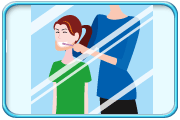An uphill battle for any parent, getting your child to brush his or her teeth can be a challenging task. For parents with special needs children, this is particularly true, due to ongoing oral-motor issues and oral sensitivities.
In order to better understand how tooth brushing can be a positive experience for both the parent and child, here are few tips for helping children with special needs brush their teeth.
1. First, let him/her face a mirror with you standing behind him/her. Using one hand to support his/her chin, and the other hand to help him/her brush.
2. If he/she can hold his/her own toothbrush, let him/her brush on his/her own. You need to supervise, observe and correct his/her brushing technique.
If the person doesn't know how to spit, it is difficult for him/her to rinse after tooth brushing.
You can first let him/her wear an apron to avoid getting his/her clothes wet. Prepare a glass of drinking water for him/her to rinse. When he needs to rinse, teach him/her to first open his/her mouth and then slowly pour the water into his/her mouth. Let the water flow out from his/her mouth so that the foam from toothpaste will be rinsed out from his/her mouth naturally.
@Swallowing toothpaste while brushing
Use only a pea-sized blob of toothpaste to brush his/her teeth. No harm will be done to his/her body even if he/she accidentally swallows the toothpaste. Fluoride is effective in preventing tooth decay and strengthening teeth, therefore it is essential that fluoride toothpaste is used. If you are worried that the fluoride content in toothpaste is too high, you might consider using children's fluoride toothpaste which contains only half of the fluoride content as the regular adult fluoride toothpaste.
@Involuntary wobbling of the head
You may stand behind him/her, use one hand to wrap around his/her head, and gently support his/her chin to stabilize his/her head. Remember to do this only if he/she is willing, otherwise he/she will refuse to brush or floss his/her teeth.
@Protruding tongue which interferes with toothbrushing
Tongue protrusion during toothbrushing is a natural reflex. You may first ask him/her to calm down and start toothbrushing for him/her as soon as he/she relaxes his/her tongue. There is only a short period of time while he relaxes his/her tongue. Therefore you may need to precisely place the toothbrush inside his/her mouth and speed up the brushing process to make toothbrushing more pleasant for him/her. You may also consider using an electric toothbrush to shorten the time needed for brushing. However, you should use a correct brushing technique with care in order to avoid damaging his/her teeth and gum.
@Biting on toothbrush
You may use some supplementary tools (e.g. a few chopsticks wrapped by a towel) for him/her to bite on one side of his/her mouth so that his/her mouth will stay opened. You can then place the toothbrush inside his/her mouth and start brushing on the other side of his/her mouth for him/her.
@Refuse toothbrushing
Find out the reason why he/she refuses to brush, then target at this reason to help him/her overcome his/her hard feelings towards brushing. If toothbrushing brings him/her discomfort, his/her gum may be sensitive due to gum inflammation. You may first choose a softer toothbrush and let him/her try to get used to brushing only a few teeth. After he/she gets used to brushing, you can then try to brush the rest of his/her teeth. Ask him/her to raise his/her hand when he/she feels uncomfortable and stop brushing to let him/her take a rest. It is important that you must not try to brush all his/her teeth by force. Otherwise, it will be difficult to change his/her attitude toward toothbrushing in the future.
@Gagging when he/she brushes his/her teeth
You may use a toothbrush with a smaller head. When you are brushing his/her molars, try not to place the toothbrush too far back as long as you can brush his/her last tooth in order to avoid gagging. If there are sensitive areas which make him/her gag, you should brush those areas last.
@Crooked teeth which are difficult to clean
You may use a toothbrush with a small head. Pay special attention to areas of irregularity to make sure that the bristles have touched the gingival margins. This could ensure that the teeth are thoroughly cleaned.
@Difficulty in inserting the dental floss into the interproximal area (area between the teeth)
Difficulty in inserting the dental floss into the interproximal area may be caused by the accumulation of calculus. The situation will improve once the calculus has been removed by the dentist. Remember to floss daily after the calculus has been removed in order to avoid accumulation again.
Hope the Blog is useful !!!
Happy Brushing :)


















very helpful mam...(my cousin )
ReplyDeleteDear Ms. Rastogi,
ReplyDeleteThanks for sharing this. Indeed these are all valuable tips.
May I request you to check your mail & revert.
Regards,